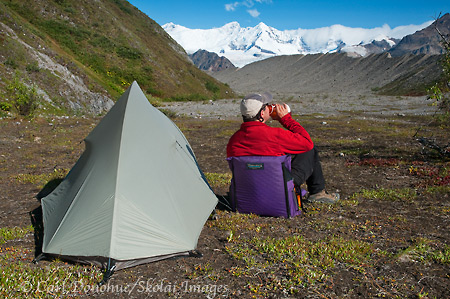
Campsite at the Fosse, near Kennicott Glacier, Wrangell-St. Elias National Park and Preserve, Alaska.
Hey Folks,
This guiding business a tough gig, I tell ya.
Cheers
Carl
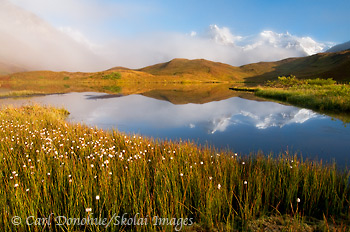
The Wrangell Mountains, covered in fresh snow, or ‘termination dust’, in early fall, and reflection in a small unnamed alpine lake. Wrangell mountains, Wrangell-St. Elias National Park and Preserve, Alaska. Please click on the image to view a larger version of the photo.
Hey Folks,
How’s this one for a turn around? I just got back from a great hike with the Ball family, a trio of Texans who came up to Alaska in 2006 and ventured out on a trip that still stands on record as the worst weather of any backpacking trip I’ve ever done. 10 days solid of near snow, ice sleet and rain the entire trip!
Hardy folks, these texans; amazingly, they came back this year for round 2. Somewhat trepidatiously, I cautiously planned the hike. We scheduled it for a route that I walked last year in nothing but horrible weather .. I figured this way, when the Texans brought their nasty weather up here, I’d be on a route I was comfortable hiking in bad weather. 🙂
Here’s the scene I awoke to Sunday morning – this is the view literally outside my tent door. What a fantastic morning, and trip overall, this was. Some great people, great scenery, and great weather. Welcome to Alaska, Texans!
We laughed a lot, hiked a lot, ate a lot, and enjoyed some of the best mountain scenery Alaska, or anywhere else, has to offer. Wrangell-St. Elias National Park and Preserve – best viewed from my tent door.
Cheers
Carl
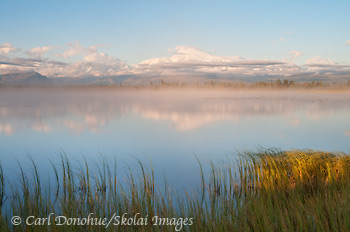
Mount Sanford and reflection, Wrangell St. Elias National Park and Preserve, Alaska. Click on the thumbnail to view a larger version of the photo.
Hey Folks,
Here’s a shot from my trip this last week to Wrangell St. Elias National Park and Preserve. I’m so wanting this shot to come together – as many times as I’ve been here, and waited for the right light, it hasn’t happened yet. This particular morning the air was calm, so the reflection was nice, and the mist added a nice touch, but the alpenglow, earlier in the morning, didn’t happen.
What’s the longest hour of a landscape photographer’s day? That hour between when the light first touches the clouds/mountain tops and when the sun actually rises high enough to light up the valley floor. Standing around, wet and cold, for an hour waiting to see if “Stage II” of the morning light happened, is a tough choice. But, then the light comes up, and it’s all forgotten. What fickle creatures we can be.
I’m pressed for time folks, but I’ll try to schedule another post or 2 for this next week. I just got in this evening and am heading out again sunday morning for 10 days. See ya soon.
Cheers
Carl
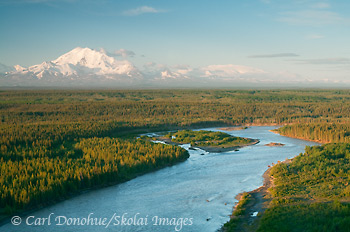
Hey Folks,
OK, enough with the waterfalls already! Here’s another image from my spring trip earlier this year, from Simpson Hill Overlook, off the Richardson Highway, near Glennallen, Alaska. This is a scene I’ll never tire of; looking down the Copper River, with the Wrangell Mountains in glorious sunshine. The mountains you can see in this image are Mt. Drum on the left and Mt. Wrangell the broader, dome-shaped mountain on the right in the background.
Just out of sight to the left of the frame is Mt. Sanford, and Mt. Blackburn to the right. How many vantage points do you know of in North America where you might choose to exclude from your photo two mountains both of which stand over 16 000′ high? That speaks volumes, in my opinion, about how amazing this viewpoint is. The 5th (Blackburn) and 6th tallest peaks (Sanford) in the US and they don’t make the photo? Craziness!
The Copper River is pretty grand too. Not to get bogged down by meaningless numbers and superlatives, but the Copper River is 300 miles long, and the 10th largest river, by volume, in the US. The Copper River is also the north and western boundaries of Wrangell-St. Elias National Park and Preserve, coolest park in all the world! It’s perhaps best known, however, for its nearly infamous Red Salmon run, usually over 2 million spawning salmon, loaded with fatty Omega-3 oils that make for some delicious supper.
I was really hoping for some sweet delicious alpenglow on this particular evening …. but ….. alas, such wasn’t to be my fortune. The light faded soon after I shot this – the boreal forest in the foreground grew dark, and the mountain light ebbed and dwindled; distant dim clouds low on the northwestern horizon thwarted my efforts at capturing some rich color on the snow-capped peaks, as seems to be the case all too often.
This scene is one of the very few ‘roadside‘ vantage points from which to photograph some of the big mountains in Wrangell-St. Elias National Park and Preserve. Willow Lake is another. The views on a clear day from these places rival anything I’ve seen anywhere else. The problem, I guess, for photographers is that the clear days are few and far between. Enjoy ’em when ya can! 🙂
Cheers
Carl
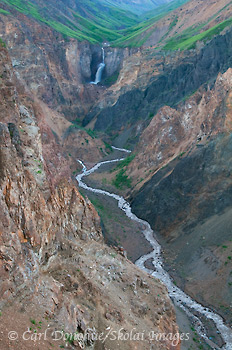
Hey Folks,
Chitistone falls are one of my favorite waterfalls in the park yet I rarely get to see them. When I do the Goat Trail now, I head north after crossing the scree slopes, and go away from the Chitistone river, rather than down lower toward the river, which is the only way to view the falls. However, this particular evening was so nice that after dinner I headed out for some photos, and knew right away I’d be spending some time watching and photographing the falls. It’s a tough slog to walk another 4 miles after backpacking all day, but can be SOOOOO worth it.
The trek down from where we’d camped was nice; it’s great to walk unencumbered after carrying a heavy backpack all day. I set out with my camera bag over my shoulder and my small backpacking tripod in one hand. For trekking I carry the carbon fiber Gitzo G1058 tripod and the ultra light Really Right Stuff BH-25 ballhead. It’s a great little combo for backpacking and hiking, weighing under 2lbs. Gitzo have since replaced this model with a newer version, the GT-0540 and GT-0530. I’m not sure how they’re different to my older one, but if you’re looking for a really great little hiking rig, this setup works well for me.
So I moseyed my way down from the high shoulder we were camped on, watching the light get sweeter and sweeter on the nearby high peaks of the University Range. When the weather is nice, few things are quite like walking alone in the Alaska mountains late in the evening. What a beautiful hike this is!
I got down to the plateau I was aiming for, and, before even pulling out my camera, simply soaked up the atmosphere. The American Tree Sparrows were still singing their summer call, those 3 vibrato-laden little notes that proclaim the alpine summer. Hardly a breath of air moved and yet the sounds of the mountains carried down the valley; a moving experience in the Chitistone Canyon.
The word ‘Chitistone‘ is derived from a native Ahtna (Athapaskan) word, ‘chiti‘, that translates as ‘copper‘ in English; so ‘chitistone‘ is ‘copper stone‘. The bulk of the rock around the Chitistone canyon is Nikolai greenstone and limestone. The entire region is famous for copper production, with Kennicott Copper Mine being perhaps the most famous of all. Fortunately, the mining has largely ended in the region now, and the canyons and mountains are left alone for the bears and Dall sheep and hikers, and the mountains themselves. It’s a grand landscape.
On a warm summer day, when the glacial melt is high, the river is fairly broiling, and the falls can be thunderous. Quite a spectacle.
This particular viewpoint has always reminded me of Artist Point, in the more famous Yellowstone National Park. This one receives far fewer visitors.
Chitistone Canyon rocks.
Cheers
Carl
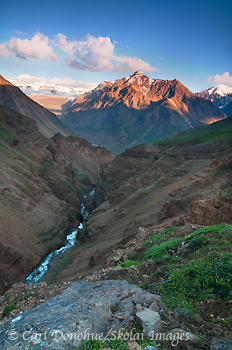
Sunset over the Chitistone Valley and University Peaks. Mount Bona stands in the background. Please click on the thumbnail to view a larger version of the photo.
Hey Folks,
One gorgeous evening, a 2 mile hike (one-way) from camp and some more photos that I had been hoping for some time now to make. Lucky me!
We just trekked from Skolai Pass, in Wrangell St. Elias National Park and Preserve, to ‘Wolverine‘, a landing strip high above the Chitistone Valley, over the relatively popular ‘Goat Trail‘. This is a classic hike, and one I try to make every summer. Before I talk about it further, I’ll qualify what I mean by ‘popular’ here.
Probably not 50 people hike this route each year, more likely 40, at most. Consider, for example, that nearly TWO THOUSAND people venture to hike the entire Appalachian Trail each year, and one starts to see that the word ‘popular‘ is entirely contextual. I only say ‘popular‘ here because so few people hike anywhere else in Wrangell-St. Elias National Park.
We had a real mix of weather on this trip, so I was SUPER lucky to grab such a gorgeous evening here at this location. the clouds dissipated throughout the course of the day, which we spent backpacking across the Goat Trail, a steep sloping scree-sided series of ravines, traversed by a meandering myriad sheep and goat trails; hitting the correct ones makes a huge difference on how easy the traverse is. The ‘wrong’ ones can easily be impassable for people, especially those carrying heavy backpacks. Continue reading
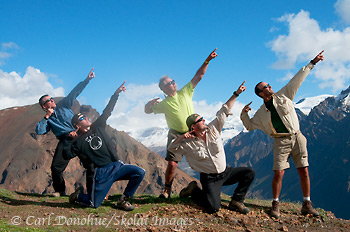
5 intrepid backpackers do ‘Usain Bolt’ after crossing the Goat Trail, Wrangell-St. Elias National Park, Alaska. Click the thumbnail to really see this classic photo.
Hey Folks,
It doesn’t get much better than this: 5 Usain Bolts in one photo! We’d just hiked across the infamous ‘Goat Trail’, of Wrangell-St. Elias National Park and Preserve, on our Skolai – Wolverine backpacking trek. The weather was awesome this particular afternoon, and what greater tribute to such a place could there be than the great Usain Bolt pose?
From your left, Chuck, Bret, Les, Carl and Rod.
In the background, the University Range and Mt Bona, 4th highest peak in the US.
The Goat Trail is a special walk for me – my first hike in Wrangell-St. Elias National Park and Preserve was down the Chitistone valley, from Skolai Pass to Glacier Creek; across the scree slopes known as ‘the Goat Trail’. Every time I walk it again it blows me away; absolutely an amazing trek. This year we had a mix of weather, and were blessed to have such a gorgeous day for our hike over the steep and nasty Goat Trail.
Why the Usain Bolt pose? Because Usain is awesome, that’s why. And, ya gotta admit, it makes a cool photo, eh?
Cheers
Carl
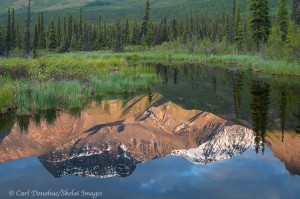
Morning reflection, beaver pond, Wrangell St. Elias National Park and Preserve, Alaska. Please click on the thumbnail to view a larger version of the photo.
Hey Folks
Here’s a quick shot from my recent few weeks in Wrangell-St. Elias National Park and Preserve. I’m leaving in the morning for the Arctic National Wildlife Refuge, and will return in 2 weeks. I’ll try to post something from that trip then. Until that time, I hope you enjoy this scene.
This photo was taken maybe an hour after dawn – around 4:30 am.
Cheers
Carl
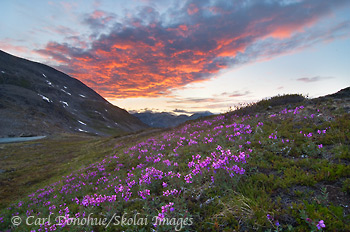
Hey Folks,
Here’s an image I took several years ago on a backpacking trek through the eastern Chugach mountains in Wrangell-St. Elias National Park and Preserve. I finally got around to processing it today. The image is a compilation of 4 separate exposures, blended together manually in Photoshop.
This is from a backpacking trip we do from Iceberg Lake to Bremner Mines in Wrangell-St. Elias National Park and Preserve. It’s a spectacular trek, and a real favorite of mine. Last summer, 2009, one participant did the trek with me for his 2nd time. We cross 2 glaciers, traverse 4 high alpine passes, and camp in some of the prettiest spots I’ve ever been to.
Summer’s approaching quickly and I’m looking forward to trudging around the mountains again. I’ll be heading over to Wrangell-St. Elias National Park this week to do some exploring, some photography and soak up some of the big mountain country. As such, I’ll be gone for a while, but hope to have some new photos to post when I return, with some stories to accompany them. Following this next few weeks I’m heading up to the Arctic National Wildlife Refuge (ANWR) for 2 weeks on the Canning River. Then it’s back to Wrangell-St. Elias for the rest of the summer, before 2 weeks in Katmai National Park in fall to photograph the great grizzly bear. That should be an amazing 2 weeks, for sure.
Continue reading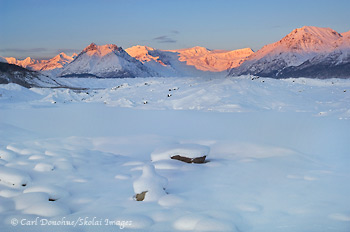
Winter snow covers Kennicott Glacier and alpenglow catches the peaks of the Wrangell Mountains and Stairway Icefall, Wrangell St. Elias National Park and Preserve, Alaska. Please click on the photo to view a larger version of the image.
Hey Folks,
The Wrangell Mountains in winter. Alpenglow catches the eastern edge of the range. This view is looking up the Kennicott Glacier. At right is the edge of Bonanza Ridge, Jumbo, Then Stairway Icefall, Donohue Peak just left of center, and the Ahtna Peaks behind that to the left.
Winter’s finally wrapping itself up here in the north; it lingers much as the sun’s final rays cling to these high peaks at days end. Spring makes it’s way north slowly, and and is completely diurnal for now. The days, growing longer weekly, yield. But the night belongs to the winter, the cold, dark silence of the quiet time.
This is the first real “view” I ever had in Wrangell-St. Elias National Park and Preserve, all those years ago when I first ventured north on a backpacking adventure. I’d taken a bus from Fairbanks south, and the weather wasn’t so great; not raining, but overcast. I didn’t really have any idea of the scale of the landscape I was amongst at the time. The bus dropped me off on the highway, at the Edgerton Cutoff, and I hitch-hiked from there in to McCarthy (about 90 miles). That was an adventure in itself, maybe I’ll recount it another time. Continue reading